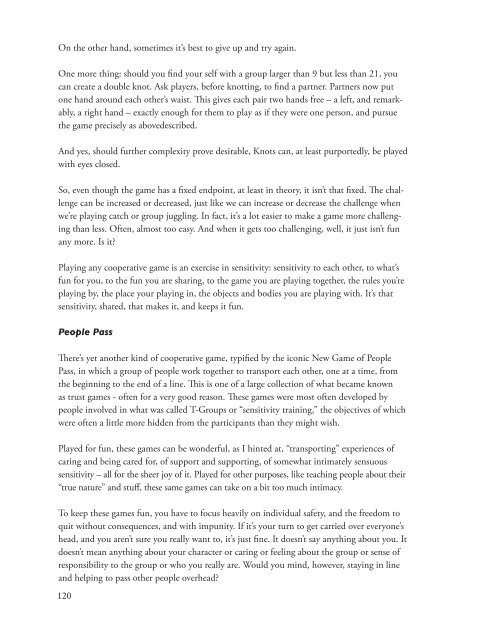A-Playful-Path_DeKoven-web
A-Playful-Path_DeKoven-web
A-Playful-Path_DeKoven-web
Create successful ePaper yourself
Turn your PDF publications into a flip-book with our unique Google optimized e-Paper software.
On the other hand, sometimes it’s best to give up and try again.<br />
One more thing: should you find your self with a group larger than 9 but less than 21, you<br />
can create a double knot. Ask players, before knotting, to find a partner. Partners now put<br />
one hand around each other’s waist. This gives each pair two hands free – a left, and remarkably,<br />
a right hand – exactly enough for them to play as if they were one person, and pursue<br />
the game precisely as abovedescribed.<br />
And yes, should further complexity prove desirable, Knots can, at least purportedly, be played<br />
with eyes closed.<br />
So, even though the game has a fixed endpoint, at least in theory, it isn’t that fixed. The challenge<br />
can be increased or decreased, just like we can increase or decrease the challenge when<br />
we’re playing catch or group juggling. In fact, it’s a lot easier to make a game more challenging<br />
than less. Often, almost too easy. And when it gets too challenging, well, it just isn’t fun<br />
any more. Is it?<br />
Playing any cooperative game is an exercise in sensitivity: sensitivity to each other, to what’s<br />
fun for you, to the fun you are sharing, to the game you are playing together, the rules you’re<br />
playing by, the place your playing in, the objects and bodies you are playing with. It’s that<br />
sensitivity, shared, that makes it, and keeps it fun.<br />
People Pass<br />
There’s yet another kind of cooperative game, typified by the iconic New Game of People<br />
Pass, in which a group of people work together to transport each other, one at a time, from<br />
the beginning to the end of a line. This is one of a large collection of what became known<br />
as trust games - often for a very good reason. These games were most often developed by<br />
people involved in what was called T-Groups or “sensitivity training,” the objectives of which<br />
were often a little more hidden from the participants than they might wish.<br />
Played for fun, these games can be wonderful, as I hinted at, “transporting” experiences of<br />
caring and being cared for, of support and supporting, of somewhat intimately sensuous<br />
sensitivity – all for the sheer joy of it. Played for other purposes, like teaching people about their<br />
“true nature” and stuff, these same games can take on a bit too much intimacy.<br />
To keep these games fun, you have to focus heavily on individual safety, and the freedom to<br />
quit without consequences, and with impunity. If it’s your turn to get carried over everyone’s<br />
head, and you aren’t sure you really want to, it’s just fine. It doesn’t say anything about you. It<br />
doesn’t mean anything about your character or caring or feeling about the group or sense of<br />
responsibility to the group or who you really are. Would you mind, however, staying in line<br />
and helping to pass other people overhead?<br />
120


